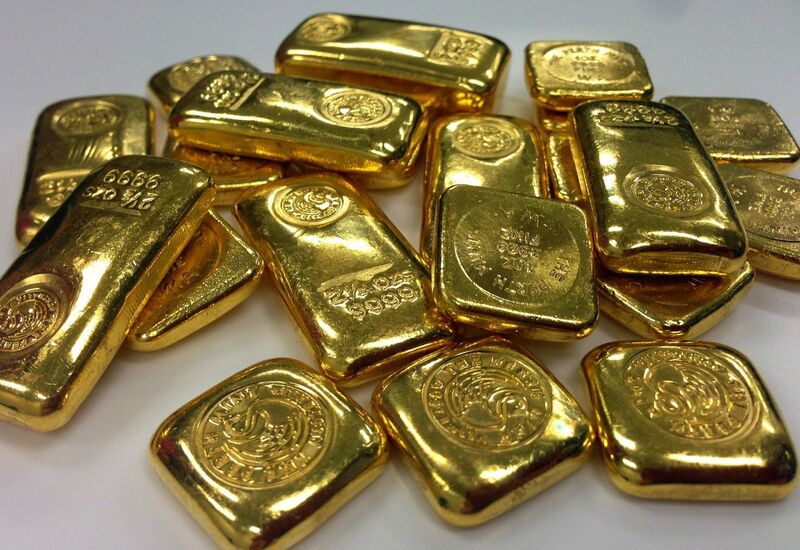
Historical trading patterns work until they do not, and gold has ignored some of the leading factors that have caused past price corrections. Gold is interest-rate sensitive because the precious metal competes with other assets for capital flows. Rising interest rates tend to cause investors and traders to purchase bonds because of attractive yields.
Since the U.S. dollar is the world’s reserve currency, it is the pricing benchmark for gold and most other commodities. A strong dollar tends to weigh on gold as it causes the gold price to rise in other currencies, leading to selling pressure.
In early 2024, gold has ignored rising rates and a strong dollar as the price has rallied to new record highs at over $2,400 per ounce. The gold bull market that began in 1999 at $252.50 per ounce remains firmly intact, with no sign of correction on the horizon.
U.S. bonds are trending lower
Interest rates have been rising since late 2023 as inflation remains stubbornly above the Fed’s 2% target.

The six-month U.S. 30-year Treasury bond futures chart highlights the decline from 126-00 on December 27, 2023, to the most recent 113-10 low on April 16, 2024. In late 2023, the market expected the Fed to ease monetary policy in 2024, but a series of hotter-than-expected inflation data over the past months has curbed the market’s enthusiasm for rate cuts. At under the 115 level on April 19, interest rates were trending higher, with the long bond futures sitting near the recent low.
The long bond futures edged 0.57% lower in 2023 and fell 3.51% in Q1 2024. The bearish price action has continued in early Q2 2024.
The dollar index is trending higher
The dollar index measures the U.S. currency against the other world reserve foreign exchange instruments. The dollar index moved 2.17% lower in 2023 but was 3.21% higher in Q1 2024.

The dollar index reached a 100.62 bottom on December 28, 2023, and has made higher lows and higher highs, moving to over the 106 level in mid-April 2024. The dollar index was in a bullish trend as the prospects for lower interest rates diminished. Interest rate differentials are the primary factor for the path of least resistance of one currency versus others.
New highs in gold- The twenty-five-year bull market continues
While stubbornly higher rates and a strong dollar are historically bearish factors for gold, the precious metal’s bull market continues to roar higher in early Q2. Gold was 13.45% higher in 2023 and gained another 7.03% in Q1 2024. Nearby COMEX gold futures settled Q1 at the $2,217.40 per ounce level.

The monthly chart dating back to the 1970s shows gold’s ascent, which took the price over $2,400 per ounce in April 2024, a new record high.
Central banks, governments, and individual investors are going for the gold
Geopolitical factors, such as ongoing wars in Ukraine and the Middle East, have supported gold. Moreover, the bifurcation of the world’s nuclear powers has significant ramifications for the global financial system. U.S. and European sanctions on Russia and Russia’s no-limits alliance with China have caused a shift in global trade.
Meanwhile, gold has become the leading asset countries hold as foreign currency reserves, with central banks buying the metal hand-over-fist over the past few years.
In 2022, central banks purchased a record 1,082 tons, and in 2023, they added 1,037 tons to reserves. The World Gold Council attributes the gold buying to “rebalancing to a more preferred strategic level of gold holdings” because of concerns over rising financial market risks and persistent inflationary pressures.
Gold’s ascent tells us more about de-dollarization and shifting global economic leadership
Meanwhile, some emerging market central banks have “become more pessimistic about the U.S. dollar’s future as a reserve currency and more optimistic about gold.”
Since Russia and China shook hands on a “no-limits” alliance in early 2022, many international transactions have circumvented the dollar. Saudi Arabia and other oil-producing countries have sold oil to China and India for non-dollar currencies.
Gold’s ascent with a strong dollar and high interest rates is a sign of the shift in global leadership in trade. Moreover, rising gold prices could be telling us that inflation is eroding all fiat currencies, including the U.S. dollar. The dollar index is a mirage as it only measures the U.S. currency against the euro, pound, yen, Canadian dollar, Swedish krona, and Swiss franc. Gold is telling us that all these currencies are losing value as inflation and a significant global financial shift are changing the worldwide economic landscape.
The trend is always your best friend in markets, and gold’s bullish trend is now twenty-five years old. High interest rates and a strong dollar have not stopped gold’s rally, which is a significant sign that the strength of the precious metal’s bullish price action will continue. Even the most aggressive bull markets rarely move in straight lines. With gold over the $2,400 level and the critical psychological support at around $2,000, a pullback to that support would not threaten gold’s long-term bullish trend. Moreover, the dramatic shifts could support a continuation of higher highs in 2024.
On the date of publication, Andrew Hecht did not have (either directly or indirectly) positions in any of the securities mentioned in this article. All information and data in this article is solely for informational purposes. For more information please view the Barchart Disclosure Policy here.






